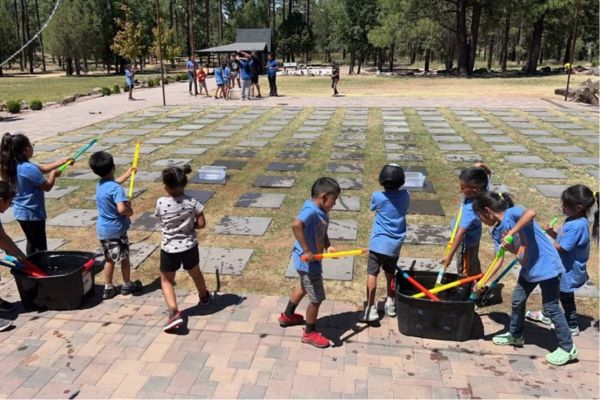
- Details
- By Kaili Berg
Camp Grace is a historic 1950’s 20-acre getaway resort situated in the tall pines of Pinetop-Lakeside, Arizona. This year, the camp is hosting its first-ever Native American Enrichment Camp to provide opportunities for Native youth to develop leadership and life skills. Some of the activities provided for Native youth include silversmithing, crafts, archery, horseback riding, and beading.
Shane Burnette (White Mountain Apache) pitched the idea of the Native American Enrichment Camp to Camp Grace, as there are no other summer camps available for Native youth in the area anymore.
“When I was growing up on the reservation, we had summer camps that we went to each summer,” Burnette told Native News Online. “They were in the mountains away from the community. There was time for us to be kids there. We learned different things like how to work by cleaning cabins and picking up trash around the lake. We talked with different professionals in the community like the police and forestry department, tribal chairman and councilman, and they would teach us how to be positive people within the community. But with all the funding cuts, the summer camp went away.”
With a rich history and elevated adventure, the camp celebrates kids of varied abilities, cultures, beliefs and backgrounds and inspires creativity and leadership. The camp is a technology-free place where Native youth can connect to the land, each other, and their culture.
“In today’s world, the number one babysitter is the laptop or phone,” Brunette said. “We want to get away from that here. I want to reteach the kids how our culture is. It’s all about being one with nature and being outside.”
A variety of different educators teach traditional values to the kids during the camp sessions.
“We had some kids that went through the silversmithing class and they walked out with a silver plated bracelet, and they were proud of it,” Burnette said. “They have fun making them, and with their finished product, they realize, wow, I can do this. You can see the light in their eyes like, wow, I didn’t know I was able to put this together.”
Eddie Gloshay Sr. teaches silversmithing, while Doug Miles Sr. teaches kids how to express themselves creatively with drawing.
The camp allows kids to enjoy their summer away from a record-breaking heatwave.
“Right now in Arizona, it is 117 degrees in Phoenix and 114 in Tucson,” Burnette said. “That’s no fun for kids, and they can’t go outside and play. It’s 82 degrees here at Camp Grace with the elevation. There is a lot to do here.”
“Everything here is laptop and phone free. Let’s go play outside, almost like going back to the old days where your parents would say ‘go outside and play, come back at dinner time’. So we’re reteaching that because I think a lot of kids forgot how to be kids without electronics.”
The camp provides a day camp (Ages 5-11) and an overnight camp (ages 12-17). There are two more Native American Enrichment camp sessions available to register for this year. The July 26-28 overnight/day sessions are still available.
More Stories Like This
Watermark Art Center to Host “Minwaajimowinan — Good Stories” ExhibitionMuseums Alaska Awards More Than $200,000 to 12 Cultural Organizations Statewide
Zuni Youth Enrichment Project Takes Top Emerging Artist Apprentices to Phoenix for Artistic Exploration and Cultural Immersion
From Dishwasher to Award-Winning Chef: Laguna Pueblo's Josh Aragon Serves Up Albuquerque's Best Green Chile Stew
Rob Reiner's Final Work as Producer Appears to Address MMIP Crisis
Help us defend tribal sovereignty.
At Native News Online, our mission is rooted in telling the stories that strengthen sovereignty and uplift Indigenous voices — not just at year’s end, but every single day.
Because of your generosity last year, we were able to keep our reporters on the ground in tribal communities, at national gatherings and in the halls of Congress — covering the issues that matter most to Indian Country: sovereignty, culture, education, health and economic opportunity.
That support sustained us through a tough year in 2025. Now, as we look to the year ahead, we need your help right now to ensure warrior journalism remains strong — reporting that defends tribal sovereignty, amplifies Native truth, and holds power accountable.
 The stakes couldn't be higher. Your support keeps Native voices heard, Native stories told and Native sovereignty defended.
The stakes couldn't be higher. Your support keeps Native voices heard, Native stories told and Native sovereignty defended.
Stand with Warrior Journalism today.
Levi Rickert (Potawatomi), Editor & Publisher


